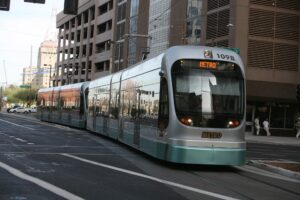EDS: An earlier version of this story miscast what $14.9 billion in tax revenue through 2045 would fund. The error occurred in the fifth graf the original. The story below has been corrected, but clients who used previous versions are asked to run the correction found here.
- Slug: Prop. 479. 800 words.
- File photo available (thumbnail, caption below).
By Hayden Larkin
Cronkite News
PHOENIX – With Proposition 479, a continuation of a half-cent sales tax in Maricopa County for transportation funding, on the ballot in November, Valley Metro and other groups are advocating for the continuation, while opponents say the tax on consumer goods is unneeded for a service few people use.
Public transit has provided Maricopa County residents with access to ease of travel. Light rail expansions, short-term rental bikes and scooters and public buses have all become viable options for city-dwelling Arizonans. With these options becoming more available, voters and groups are butting heads over the taxation and costs of expanding these transit systems. Some places in Maricopa County also may not have the means to afford certain forms of public transit to be able to expand into their cities.
About 84% of Arizonans live in a community with unhealthy air, according to an American Lung Association report from December.
“One of our goals is to provide sustainable transit options. And when you take light rail, when you take a streetcar, you’re taking zero-emission transportation,” said Juliana Vasquez-Keating, public information officer for Valley Metro. “Light rail operates 100% electricity, so it produces zero direct emissions while it’s operating.”
Prop. 479 would help to keep a 30-minute average commute time, according to Maricopa Association of Governments. About $9 billion of the $28.2 billion plan would fund transit services. The sales tax would generate about $14.9 billion through 2045, which would help to create 28.3 miles of bus routes as well as new traditional and HOV freeway lanes and help to maintain the light rail system. Additionally, federal and local funds would be used to create 11.9 new miles of light rail.
“(It) not only funds public transit, it funds roads, it funds all these things,” Vasquez-Keating said. “So we just want to continue funding our transportation so more people have a sustainable way to get around.”
Valley Metro is planning Interstate 10 extensions to connect west and central Phoenix. And a 5-mile extension to south Phoenix in the starting phases of construction. Though Valley Metro does receive grants from the U.S. Department of Transportation, it also gets regional funding from sales taxes such as Prop. 479 its and previous forms: Prop. 400 passed in 2004; and Prop. 300 passed in 1985.
“We know that Maricopa County is one of the fastest-growing counties in the country, and we’ve just continued to see that population increase,” Vasquez-Keating said. “So as we work to expand our system, we know that it’s going to serve even more people as we continue to grow.”
While Valley Metro doesn’t serve all of the metro Phoenix area, other towns and cities would still access Prop. 479 funds. Glendale has its own forms of public transit funded partially by the sales tax, including bus routes and the Glendale Urban Shuttle, its version of Dial-a-Ride. But it won’t use the funds toward light rail.
“Due to the cost of light rail and a lack of regional and state funding, the city of Glendale will not extend light rail services into Glendale but will instead continue to focus on providing frequent and accessible transit to all our residents and visitors through multiple service options,” a city of Glendale spokesperson said.
There are also opponents to the proposition, including the Goldwater Institute, a conservative think tank that referred Cronkite News to the Arizona Free Enterprise Club, which did not respond to a request for comment. They believe that the tax for transit projects is unneeded with the former deeming light rail “an abysmal failure.”
The Goldwater Institute says on its website that fewer than 1% of Valley residents use light rail, and the organization doesn’t want residents paying for services they don’t use as the cost of living increases. Valley Metro’s 2024 fiscal year reporting showed over 36.8 million boardings of its public transit services, with about 11 million of those being light rail and streetcar usage.
“This is not what residents had in mind when they originally agreed to pay more taxes to fund Maricopa freeways. At a time of excessive housing costs, runaway inflation, and rising costs of basic goods and services, residents should not be expected to pay even more in taxes for government projects that they will never benefit from,” the Goldwater Institute says on website.
But advocates of Prop. 479 say having more transit options means fewer single-occupancy vehicles and emissions.
“By passing Prop. 479, Arizonans will have more ability to use a bus, to have improved arterial roads and to have new HOV-lane miles,” said Diane Brown, executive director of the Arizona Public Interest Research Group. “Each of which can cut down on idling of vehicles, which contributes to our air quality.”
